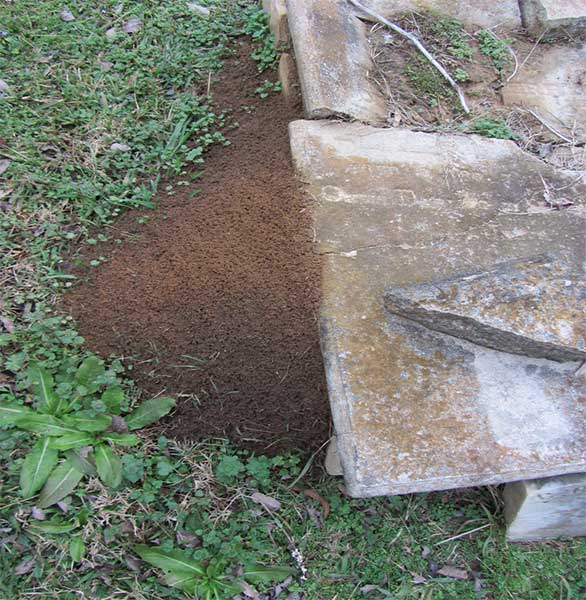Welcome To Our Fire Ant Learning Center
Fire AntsFire Ants are a reality of life here in Texas. These ants are aggressive, and their painful, burning sting results in pustules that may take up to ten days to heal. The Red Imported Fire Ant is not native to the United States. It entered the U.S. about 1940 and spread rapidly.
Fire Ant Treatment
These ants are mean enough that they require their own page to describe how Stride Pest Control treats these little monsters. Our Topchoice® treatment option requires only a single application to control existing colonies for up to a year while also preventing new infestations from forming.

Click on any heading below to learn more about Stride’s Control Process.
Inspection
Our treatments start with a thorough inspection of the landscaping. If the ants have entered the home or business we check those areas as well.
Identification
Proper identification is key since every species of ant is controlled in a little different way. Some need a protein-based bait, while others are more attracted to sweets. In lawns, fire ant mounds can be flat or dome-shaped and are usually just a few inches tall. Mounds look like sand that has been “worked.”
Recommendation
We’ll make two treatment recommendations for you to choose from.
Treatment
One effective method for treatment is the Texas two-step approach done by our Austin fire ants pest control & exterminator. This includes a broadcast treatment of all turf with a granule and individual treatment of active mounds with an appropriate bait. This can control fire ants for a time, but they will usually return after a big rain.
Even better is our upgraded preventive granule called Topchoice®. A single application controls existing colonies for up to a year while also preventing new infestations from forming.
Evaluation
Prevention is the key when it comes to fire ants. The best way to prevent is to apply Topchoice® in the early spring (Feb & March) before the rains hit. Then have us return regularly to granulate and check/treat any active mounds. This is typically done with one of our pest control maintenance programs.
Additional Information
Description
Some imports are well-liked, like entertainment and food. Pests in Austin, like fire ants, on the other hand, are not welcome in the United States. Farmers and homeowners work hard to eliminate them from their properties, as they cause health issues and damage to crops and plants.
Fire ants are reddish brown in color and about the same size as ordinary ants. They are 1/8 to 1/4 inch in length. The main difference is that they have a distinct stinger at the end of their abdomen.
Fire ants live in colonies that can consist of thousands or even hundreds of thousands of individual ants. Each colony has a queen, whose primary role is to reproduce. There are also worker ants that gather food, tend to the brood, and defend the colony.
Fire ants build large, dome-shaped mounds made of soil. These mounds can be several feet in diameter and are typically built in open areas. The mounds provide shelter and protection for the colony and also help regulate the temperature inside. Fire ants have been known to build mounds as large as 2 feet tall and 3 feet in diameter. In heavily infested areas, there may be as many as 50 mature colonies per acre.
Habits & Behavior
Fire ants are not native to the United States. They are originally from South America and were introduced to various parts of the world, including the southern United States. Fire ants can be found in Texas and a dozen other states, including California, Florida, Virginia, Alabama, Louisiana, Georgia, Mississippi, North Carolina, and South Carolina.
Fire ants also live in Australia and several Asian countries. They thrive in warm climates and prefer sunny areas with sandy soil, such as lawns, pastures, and agricultural fields.
Fire ants are aggressive and known for their painful bites and stings. When their nest is disturbed or they perceive a threat, they will swarm and attack. Their stings are very painful and can cause a burning sensation as well as itching and blisters. The pain can last for several days.
Fire ants are omnivorous and have a varied diet. They feed on plant matter, insects, small vertebrates, and even carrion. The fire ant’s diet includes insects, earthworms, ticks, and spiders. They are known to be particularly attracted to sweet substances like honeydew melon and other sugary foods and nectar. They are also known to eat meats, greasy materials, and arthropod eggs.
Environmental Impact
Fire ants can have a significant impact on ecosystems where they have been introduced. They destroy crops, feeding on the buds and fruits of corn, soybean, okra, and citrus fruits. They can also destroy young trees. They may create large nests located in fields and damage equipment during cultivation and harvesting.
Fire ants compete with native species for food and resources and can prey on other insects and small animals. Their aggressive nature and ability to form supercolonies can displace native ant species.
Threat of Fire Ants
 You don’t want to mess with fire ants. Fire ants will attack anything that disturbs their mound. They firmly grasp skin with their jaws. They will then sting and inject venom. Fire ants can inflict multiple stings in a circular pattern.
You don’t want to mess with fire ants. Fire ants will attack anything that disturbs their mound. They firmly grasp skin with their jaws. They will then sting and inject venom. Fire ants can inflict multiple stings in a circular pattern.
Within 48 hours, the sting of a fire ant can develop into a small, blister-like sore called a pustule. Pustules can take 10 days to heal. If the pustules break, they can cause an infection. Those who have allergic reactions to fire ant venom can suffer from nausea, shock, and chest pains. Some even have serious reactions such as heart attacks, seizures, and coma. Fire ant venom can cause death in rare cases.
Fire ant mounds in yards, playgrounds, and recreational areas are a hazard to children and pets. A single fire ant can sting its target repeatedly. Young and newborn animals are especially susceptible to fire ant venom.
If you do get attacked, leave the area immediately. Brush off ants with a gloved hand or by using a cloth. If you experience minor bites and irritation, contact your doctor for medication and treatment. If you feel short of breath or have swelling, seek immediate medical attention.
Exterminating Fire Ants
Due to their invasive nature and potential harm to humans and ecosystems, it’s important to control fire ant populations. The most effective way to kill fire ants is to use the two-step method: baiting and mound drench. The first step involves using bait to kill the queen and other worker ants. The second step is to use insecticide for targeted treatments on the mounds. It’s best to treat fire ant infestations in cooler weather, so aim for the early morning or late evening hours. This is the time when the ants are actively foraging.
If you have fire ants indoors, you can use baits and sprays. Baits can be placed in an area where you have seen ant activity in the home. Some possible locations include near drains, in kitchen cabinets, under the stove and refrigerator, and around pipes and wall outlets.
You don’t want to mess around with fire ants. Stride Pest Control knows how to get rid of these annoying pests for good. Our Top Choice® treatment option requires only a single application to control existing colonies for up to one year. This treatment also prevents new infestations from forming. Consider professional pest control today to get your home and yard free and clear of fire ants and other annoying pests.
Contact Us Today
Fire ants can be a nuisance to fields, yards, homes, and businesses. They can cause damage to the environment as well as injuries to humans and pets.
Fire ants need to be effectively controlled. Stride Pest Control can help. Our team of Austin pest control professionals can help you eliminate fire ants and other pests from your home and yard. You don’t have to live with the stress, pain, and suffering of fire ants anymore. Schedule a free inspection with Stride Pest Control today by calling (512) 777-1339 (Austin) or (210) 547-8410 (San Antonio) or filling out the online form.
Number of potential Fire ants in one colony
200,000
Potential size of one fire ant mound
5′ sqr
Days to heal from a fire ant sting
10
Number of potential Fire ant mounds per acre
20-30
GET A FREE CONSULTATION TODAY!
Get a FREE Consultation

